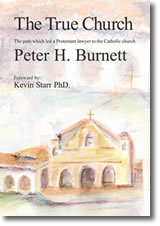This weighty tome (two volumes in one), originally published in 1860, is a frontier Apologia pro vita sua written by a lawyer who converted from a protestant movement, known as the Stone-Campbell Restoration Movement, to Catholicism while in Oregon, and went on to become the first Governor of California. The remarkable path traveled by the author and the brilliance of his reasoning make his book valuable today as a work of apologetics and as a historical document.
Whereas the cumulative force of patristic writings brought the scholar Newman into the One True Church, Burnett’s key insight was that a New Covenant implies a people governed by a New Law. “It does seem to me that the Catholic theory [of a visible Church] honors Christ as a lawgiver. The Protestant theory [of sola Scriptura and individual interpretation] degrades Him, as such, below the standard of mere human legislators.” In an age when Catholics were regarded as un-American, Burnett reasons a fortiori that if the Founding Fathers vested authority in the three branches of the United States government, surely Christ must have established lasting structures of authority in his Church.
 Burnett applies his legal acumen to a range of standard topics from apologetics. He cites the Anglo-American rules of evidence while arguing that the truth and divine inspiration of Scripture is proved by miracles. He gives a spirited defense of priestly celibacy and religious life, and refutes the scurrilous charges of the day by examining the reliability of the Protestant “testimony,” which is marred by patent misrepresentations and tinged with “an eagerness to believe ill of Catholics.”
Burnett applies his legal acumen to a range of standard topics from apologetics. He cites the Anglo-American rules of evidence while arguing that the truth and divine inspiration of Scripture is proved by miracles. He gives a spirited defense of priestly celibacy and religious life, and refutes the scurrilous charges of the day by examining the reliability of the Protestant “testimony,” which is marred by patent misrepresentations and tinged with “an eagerness to believe ill of Catholics.”
Nineteenth-century religious controversy was conducted in a courtroom style. This gave Burnett a decided advantage. He frames his arguments on a grandiose scale, like his contemporary, Orestes Brownson, but he writes with greater clarity and concentrated force than the philosopher. He restates a Protestant objection as a series of propositions and then makes an airtight case against each of them.
Burnett is particularly thorough but always gentlemanly in dismantling the arguments for non-institutional Christianity made by Alexander Campbell (who to this day has thousands of disciples west of the Appalachians). Burnett does not hesitate to cite the standard apologetic works of his contemporaries. Cardinal Nicholas Wiseman, in particular, supplies catenae of passages from the Church Fathers in support of Catholic doctrines such as Transubstantiation.
Some of Burnett’s solutions to Scriptural difficulties are wonderfully elegant. He answers Protestant controversies about John 6 by pointing out that, up until verse 47, Jesus is “speaking of Himself under the image of bread” from heaven given by the Father, whereas later in the chapter “He speaks of the food now described as being given by Himself. This marked difference in the giver, shows a difference in the gift,” i.e., the difference between the Savior sent by God, in whom Christians believe, and the Sacrament instituted by Christ, which Catholics consume.
Vatican II described the Catholic Church in terms that went beyond mere legalism, emphasizing that the Church is a sacramental mystery. Many Catholics today, however, need to be reminded that there is a juridical aspect even to the sacraments: Baptism is divine adoption with a right to an inheritance. Penance is a tribunal in which the sinner accuses himself and is acquitted by God’s mercy. Holy Orders confers supernatural authority for the governing of the Church, which necessarily has a hierarchical structure.
Burnett’s keen legal mind presents these New Testament truths with forceful logic. Brownson was right when he described The True Church as worth more than all the gold taken out of California.
Michael J. Miller
Glenside, Pennsylvania
Recent Comments